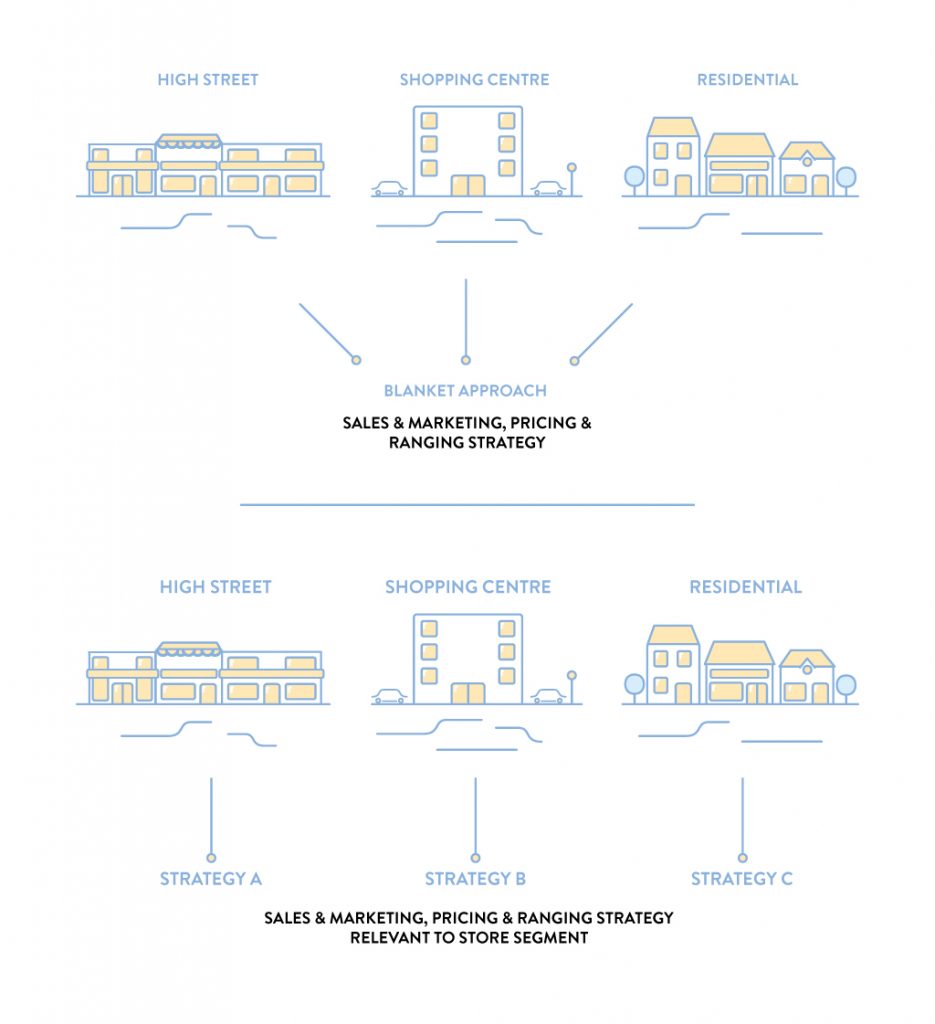As data insight and analytics specialists, we understand the importance of retail store segmentation, analysing stores at individual site and estate level . All too often, retailers forget that each of their sites, although part of a larger chain, will have differing characteristics and potential proposition dependent on its location and key site attributes.
Store segmentation is the process of grouping stores with common characteristics. This enables optimisation of store level activity including ranging, pricing, merchandising and promotions that are suitable for that particular segment of store. I will expand on the process and benefits of store segmentation later.
If each store is different, it stands to reason that stores shouldn’t be treated the same, with a blanket approach to sales and marketing activity. This potentially extends to a different pricing and ranging strategy.
We help our clients understand how each of their stores will perform, based on different factors. For instance, it’s site location (High Street, Residential, Retail park), nearby proximity drivers (transport hubs, attractions, transient work force), local competitors and the consumer profile within catchment.
The segmentation model most appropriate for your organisation, will be dependent on the nature or type of business. A bespoke segmentation will inevitably use a hybrid of factors based on relevancy. 2 basic store segmentation models are based on store characteristics or shopper driven characteristics as follows: –
Store Driven Segmentation
- Geographic location (region, climate)
- Store location type (high street 1, high street 2, retail park, residential, rural, industrial site)
- Store size (sq. footage)
- Footfall, number of transactions
- Product ranging & service offered
Shopper Driven Segmentation
- Purchase type – impulse, convenience, compulsory purchase
- Demographics – age, gender, income, affluence & life stage
- Behaviour – values, interests & hobbies
- Transactional – product split & spend
By grouping stores by similar types, it’s possible to optimise range, price and merchandising that relate to the target audience or offering for that particular segment. This approach prevents retailers or brands from applying a one size fits all approach that can result in stores under-performing.
To ensure all stores can perform to the best of their potential, price points and range of products needs to be in line with the target audience, in other words, consumers that are likely to use the store and be interested in your offering. A good example of this would be a travel agency mistakenly promoting 18-30 holidays across their entire estate and therefore promoting this holiday in an area with an ageing population, where you can assume the uptake would be low!
Once a retailer’s stores have been segmented, they will be able to roll out a more meaningful activity that is aligned to its potential customers. In this way, store segmentation enables a more targeted approach that will increase customer satisfaction and engagement and improve overall sales performance.
Performance Monitoring
Understanding the make-up of your stores also enables retailers to monitor and track performance by segment type. Tracking store performance based on segment allows comparison and opportunity mapping. Once you can identify the stores that are under-performing against potential, you can allocate the right resources. Prioritising resource to stores that need to attain more growth whilst keeping an eye on stores that only need to maintain their current sales or growth margins. Store segmentation enables cross store analysis and the ability to optimise resource allocation based on likely profitability.
Store Segmentation Process
Segmentation projects consist of 4 main elements to succeed: segmentation, targeting, positioning and developing an optimal marketing mix to cater for the needs of each store segment.
Store Segmentation – based on a single or mix of defining traits that a group of stores share.
Targeting – understanding the target audience for each of these store groups their likely needs and buying behaviour.
Product Positioning – Using the different segment groups to decide on the different product positioning and ranging required for each.
Optimal Marketing Mix – Developing the right marketing mix to appeal to the target audience for that type of store.

Benefits of Store Segmentation
- Developing bespoke sales and marketing mix with promotional activity to suit each store’s specific target audience
- Informs retailers of where prioritisation of resource or investment is needed based on store opportunity
- Optimisation of store and category space based on potential uptake of specific products
- Ability to size the market opportunity around each store based on its segment type and catchment
- Improving customer engagement providing the right products and pricing in the right stores
- Develops tailored customer service appropriate to store strategy
In summary, store segmentation is a valuable exercise for all retailers. Understanding the mix of your stores and how to optimise the right mix of products, merchandising and promotions will improve overall profitability for each. Furthermore, the more you can tailor your offering for the relevant audience, the more sales you will generate.
Read some client case studies on store segmentation below:-
- Vue Cinemas – Estate Segmentation
- WHSmith – Store Segmentation
- Coca Cola European Partners – Estate Segmentation
- Tui Travel – Customer Profiling & Estate Segmentation
To find out more information or talk about your store segmentation project call us on 01926 887555 or email store segmentation query.

